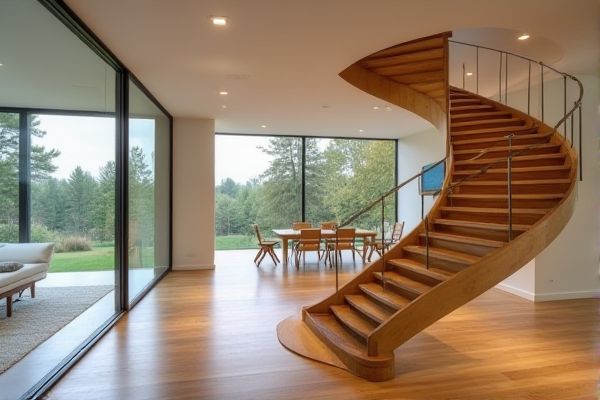
Helical stairs provide a smooth, elegant curve with a central void, offering more space and a modern aesthetic compared to the compact, tightly wound design of spiral stairs. Explore the rest of this article to understand which stair type best suits Your space and style needs.
Table of Comparison
| Feature | Helical Stairs | Spiral Stairs |
|---|---|---|
| Design | Curved, open central space | Coiled around a central pole |
| Space Efficiency | Moderate space usage | Highly space-efficient |
| Construction Complexity | Complex, requires custom fabrication | Simpler, often prefabricated kits |
| Cost | Higher due to design and materials | Generally lower cost |
| Safety | Safer with wider tread width | Can be narrow, less safe for high traffic |
| Aesthetics | Modern, elegant appearance | Traditional, compact look |
| Applications | Large residential or commercial spaces | Small apartments, tight spaces |
Introduction to Helical vs Spiral Stairs
Helical stairs feature a smooth, curved design without a central pole, providing a spacious and elegant ascent ideal for larger areas. Spiral stairs wind tightly around a central support, maximizing space efficiency and often used in compact environments. Choosing between helical and spiral stairs depends on your available space, aesthetic preference, and functional requirements.
Defining Helical Stairs
Helical stairs are curved staircases that follow a smooth, sweeping arc around a central void without a central pole, differing from spiral stairs which coil tightly around a central column. Helical stairs provide a broader tread and more open design, enhancing both aesthetics and safety in residential or commercial architecture. Their structural complexity often requires precise engineering and custom fabrication to ensure stability and seamless integration into various architectural layouts.
Defining Spiral Stairs
Spiral stairs are defined by their tight circular design winding around a central pole, maximizing vertical space with a compact footprint ideal for small areas. Unlike helical stairs that feature a broader, more open curved shape without a central support, spiral stairs maintain consistent step dimensions and a uniform radius for efficient climbing. Their structural reliance on the central column differentiates them from helical stairs, affecting installation complexity and design flexibility.
Key Structural Differences
Helical stairs feature a continuous, sweeping curve with a central void but no central support column, relying on an outer stringer and individual steps anchored to the structure for stability. Spiral stairs are built around a central pole or column that supports the treads, creating a compact, circular footprint ideal for tight spaces. The structural design of helical stairs offers more open aesthetics and wider treads, while spiral stairs are typically steeper and more space-efficient due to their central support mechanism.
Aesthetic Appeal and Design Flexibility
Helical stairs offer a sleek, contemporary aesthetic with smooth, flowing curves that create an open and elegant visual impact, while spiral stairs typically feature a tighter, more compact design suited for saving space. Helical stairs provide greater design flexibility with customizable radius, step width, and materials, allowing you to tailor the structure to fit your architectural vision and interior style. Your choice between these stairs depends on the balance of visual sophistication and spatial efficiency required for your project.
Space Efficiency Comparison
Helical stairs offer a balanced space-saving solution with a more gradual curve and larger footprint, making them suitable for areas where comfort and aesthetics matter. Spiral stairs maximize space efficiency by occupying a minimal footprint with a compact, tight circular design ideal for small or constrained spaces. Your choice depends on whether you prioritize ease of movement or the absolute minimization of floor space in your architectural layout.
Installation Complexity and Cost
Helical stairs typically involve more complex installation processes due to their larger radius and custom design requirements, often resulting in higher labor costs and longer timelines. Spiral stairs, with their compact structure and pre-fabricated components, generally offer easier installation and lower expenses, making them a cost-effective choice for tighter spaces. Your decision should balance the desired architectural impact against the budget and the installation feasibility of each staircase type.
Safety and Accessibility Considerations
Helical stairs offer enhanced safety due to their wider, consistent tread width and smoother curvature, reducing trip hazards compared to spiral stairs with their tight, often uneven steps. Accessibility is improved on helical stairs as they accommodate handrails on both sides and provide more comfortable ascent and descent for individuals with mobility challenges. Spiral stairs present safety risks because of their narrow inner radius and steep incline, often limiting use for elderly or disabled users.
Ideal Applications and Use Cases
Helical stairs are ideal for expansive spaces like commercial buildings and luxury homes where aesthetic appeal and smooth, flowing design are priorities. Spiral stairs suit compact areas such as small apartments, lofts, and attics because of their space-saving circular footprint. Both stair types provide vertical access but differ in structural complexity and spatial impact, influencing their ideal use in architectural design.
Conclusion: Choosing the Right Staircase for Your Space
Helical stairs offer a smooth, elegant curve with wider treads, providing a more comfortable ascent and a modern aesthetic suited for spacious interiors. Spiral stairs save space with their compact, circular design, making them ideal for tight areas but may be less convenient for frequent use due to narrower steps. Selecting between helical and spiral stairs depends on balancing space constraints, style preferences, and usability requirements for your specific architectural environment.
 homyna.com
homyna.com